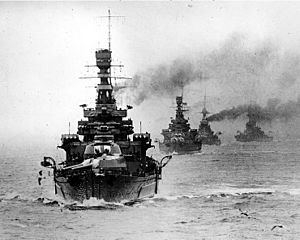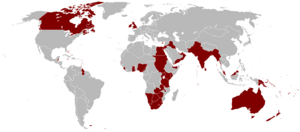Singapore strategy facts for kids
Quick facts for kids Singapore strategy |
|
|---|---|

HMS Repulse leads her sister ship HMS Renown and other Royal Navy capital ships during manoeuvres in the 1920s
|
|
| Era | 1919–1942 |
| Battlespace | Sea |
The Singapore strategy was a big plan to defend the British Empire in Asia. It was mainly designed to protect against attacks from Japan. This plan involved many different ideas and stages. These ideas were developed between 1919 and 1941.
The main idea was to have a large group of ships, called a fleet, based in the Far East. This fleet would then be ready to stop and defeat any Japanese forces. These forces might try to move towards India or Australia. In 1919, Singapore was chosen as the main base. This was because it was in a very important spot at the end of the Strait of Malacca.
Contents
What Was the Singapore Strategy?
The people who planned the strategy thought a war with Japan would happen in three parts. First, the soldiers defending Singapore would protect the fortress. While they did this, the main British fleet would travel to Singapore.
The Plan's Steps
Once the fleet arrived, it would help defend Singapore. It could also try to take back Hong Kong if it had been captured. Another idea was to stop Japanese ships from entering or leaving their ports. This is called a wikt:blockade. This would put pressure on Japan to agree to peace.
The planners did not think it was possible to attack and take over Japan itself. They also believed that Japan would want to fight a big battle at sea. Since Japan is made up of many islands, the planners thought that stopping their trade would be enough.
Why the Strategy Failed
The Singapore strategy was the most important part of Britain's defense plan in the Far East during the 1920s and 1930s. By 1937, many people believed in it very strongly. They thought it was a perfect plan that could not be wrong.
However, over time, many problems appeared. One big problem was that carrying out the strategy cost a lot of money. There were also political and practical difficulties. Because of all these problems, the strategy could not be fully put into action.
During the 1930s, people in Britain and other countries often criticized the strategy. For example, Australia used the strategy as a reason to spend very little money on its own defense.
The Fall of Singapore
The strategy eventually led to a group of British warships, called Force Z, being sent to Singapore. Sadly, two of these ships, the Prince of Wales and the Repulse, were sunk by Japanese planes on December 10, 1941.
After this, Singapore itself was captured by the Japanese. This was a very shameful defeat. Winston Churchill, who was the British Prime Minister, called it "the worst disaster and largest capitulation in British history." The Japanese Occupation of Singapore then began.
Images for kids
-
HMS Repulse leads her sister ship HMS Renown and other Royal Navy capital ships during manoeuvres in the 1920s
-
The troopship RMS Queen Mary in Singapore Graving Dock, August 1940
-
Troops of the Australian 8th Division arrive at Singapore Harbour on August 15, 1941.
-
HMS Prince of Wales leaves Singapore on December 8, 1941
-
HMS Repulse leaves Singapore on December 8, 1941
-
Lieutenant General Arthur Percival (right) goes to negotiate the surrender of Allied forces in Singapore on February 15, 1942.
See also
 In Spanish: Estrategia Singapur para niños
In Spanish: Estrategia Singapur para niños










